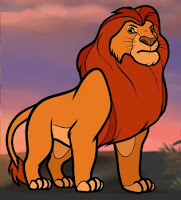The Lion King (1994) American animated musical-adventure film produced by Walt Disney Feature Animation. The story takes place in a kingdom of lions in Africa.
Children might be observing and influenced by the dark lion in the film Scar. Children might be associating dark skin color with “bad” and apply it in real life by thinking dark skinned people are bad. Critics discuss the facial difference between Mufasa and Scar. “Don’t know if I’m overreacting but it seems like to me, Scar has Saracen like facial features and Mufasa has a more Frankish looking face/mane.” I can somehow relate to this. I believe that the facial difference between the two lions is extremely noticeable. I believe that children can associate the dark color of Scar with evil and that can be represented as racist stereotyping. I believe that can be extreme issue for children watching this movie, because once again they will be focused on the bad lion, with dark skin and black beard. The good lion is light skin, expected to represent white race and is associated with good behavior, he is the keeper, and he is the one all other animals cherish. This can be a potential danger to children; since they might believe it is okay for dark skinned people to be bad.
In the scene where Simba and Nala lie to their parents about going to the waterfall, they get in danger with the hyenas; which are represented as the evil in the film. This may be absorbed that lying to parents always leads to bad situations and never turns out positive. Mufasa shares with Simba: “Simba, being brave does not mean get into trouble.”
 I remember crying on this movie, asking why the King had to die. I remember thinking that when something bad happens, something good turns up. In the movie Simba finds two friends, which make him feel better. I also remember thinking that friends always come together sooner or later. I remember Simba being scared to go back home because he was afraid everyone will hate him. Simba’s friends help him gain his kingdom back, because they believed its fair for him to go back home.
I remember crying on this movie, asking why the King had to die. I remember thinking that when something bad happens, something good turns up. In the movie Simba finds two friends, which make him feel better. I also remember thinking that friends always come together sooner or later. I remember Simba being scared to go back home because he was afraid everyone will hate him. Simba’s friends help him gain his kingdom back, because they believed its fair for him to go back home.
When the King is killed by his own brother, children might assume that family is not always there to protect, instead it might harm.
 I remember crying on this movie, asking why the King had to die. I remember thinking that when something bad happens, something good turns up. In the movie Simba finds two friends, which make him feel better. I also remember thinking that friends always come together sooner or later. I remember Simba being scared to go back home because he was afraid everyone will hate him. Simba’s friends help him gain his kingdom back, because they believed its fair for him to go back home.
I remember crying on this movie, asking why the King had to die. I remember thinking that when something bad happens, something good turns up. In the movie Simba finds two friends, which make him feel better. I also remember thinking that friends always come together sooner or later. I remember Simba being scared to go back home because he was afraid everyone will hate him. Simba’s friends help him gain his kingdom back, because they believed its fair for him to go back home. I think my child would be able to learn how bad behavior can ruin nature and its beauty. The impact of bad decisions can harm others, and lying does not bring anything positive; it brings mistrust and hate. I think my child would be able to appreciate the struggle Simba fought against his uncle, in order to gain his life and family back; as well as bring the Kingdom back to its life and beauty. I believe the lesson my child can learn is bad behavior should always be punished. Accepting responsibilities and taking important steps in order to learn from mistakes.
Critics share their view: “The characters are animals, but their voices show racist stereotypes. Even though The Lion King takes place in Africa, two white American actors are used for the voice of Simba, the hero. However, the hyenas who are bad characters in the film, speak non-standard English.” I do not agree with this statement because I do not think the fact that the movie takes place in Africa matters as much, and also the voices are simply voices that do not show racism.When talking about stereotyping existing in the film Lion King, a viewer shared: “I was dismayed at the use of ethically identifiable voices to characterize the hyenas, clearly the undesirables in the film. The Spanish-accented voices clearly marked the hyenas racially.” Again, this comment shows how important voices are in the movie, I believe they are simply chosen; they do not discriminate against or use stereotyping. Yes the hyenas did represent Spanish-accented voices, but it is not what makes them bad; it is the animal type that writers are trying to put a face on, not the language used. Hyenas are extremely dangerous animals that are known for their bad characteristics.
Research








